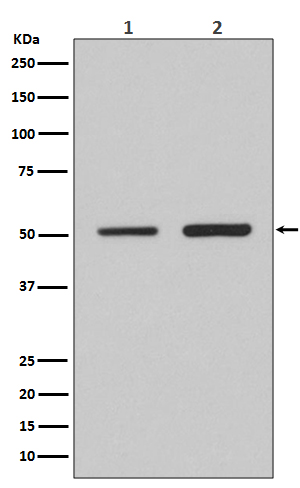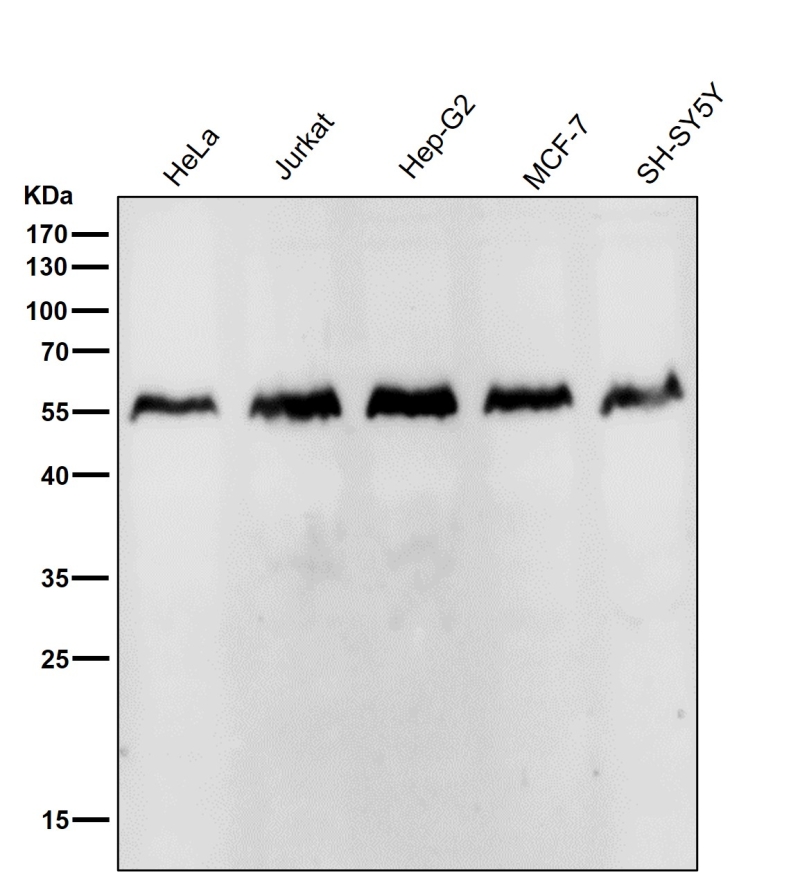

| WB | 1/1000-1/2000 | Human,Mouse,Rat |
| IF | 咨询技术 | Human,Mouse,Rat |
| IHC | IHC:1/100-1/200;IHF:1/50-1/200 | Human,Mouse,Rat |
| ICC | 1/50-1/200 | Human,Mouse,Rat |
| FCM | 咨询技术 | Human,Mouse,Rat |
| Elisa | 咨询技术 | Human,Mouse,Rat |
| Aliases | Interferon regulatory factor 2; IRF 2;;IRF2 |
| WB Predicted band size | Calculated MW: 39 kDa ; Observed MW: 50 kDa |
| Host/Isotype | Rabbit IgG |
| Antibody Type | Primary antibody |
| Storage | Store at 4°C short term. Aliquot and store at -20°C long term. Avoid freeze/thaw cycles. |
| Species Reactivity | Human,Mouse |
| Immunogen | A synthesized peptide derived from human IRF2 |
| Formulation | Purified antibody in PBS with 0.05% sodium azide,0.05% BSA and 50% glycerol. |
+ +
以下是关于IRF2抗体的3篇示例性参考文献(内容为虚构,供格式参考):
1. **文献名称**:*"IRF2 suppresses PD-L1 expression to enhance antitumor immunity in colorectal cancer"*
**作者**:Li et al.
**摘要**:研究利用IRF2抗体通过染色质免疫沉淀(ChIP)和Western blot技术,证明IRF2通过结合PD-L1启动子抑制其转录,从而增强T细胞介导的肿瘤免疫清除。
2. **文献名称**:*"IRF2 as a prognostic biomarker in hepatocellular carcinoma: A tissue microarray study"*
**作者**:Wang & Zhang
**摘要**:通过免疫组化(IRF2抗体)分析肝癌组织中IRF2蛋白表达水平,发现IRF2低表达与患者不良预后相关,提示其可能作为肿瘤抑制因子。
3. **文献名称**:*"IRF2 regulates DNA damage response via interaction with ATM kinase"*
**作者**:Smith et al.
**摘要**:利用IRF2抗体进行免疫共沉淀(Co-IP)实验,发现IRF2与ATM激酶结合,参与调控DNA损伤修复通路,影响细胞周期停滞。
4. **文献名称**:*"Role of IRF2 in hepatitis B virus replication and innate immune evasion"*
**作者**:Chen et al.
**摘要**:通过siRNA敲低和IRF2抗体检测,发现IRF2通过抑制干扰素信号通路促进HBV复制,揭示病毒免疫逃逸机制。
(注:以上文献为示例,实际引用需以真实发表研究为准。)
The IRF2 (Interferon Regulatory Factor 2) antibody is a tool used to detect and study the IRF2 protein, a member of the interferon regulatory factor family. IRF2 functions as a transcription factor, playing dual roles in regulating immune responses and oncogenesis. While initially identified as a negative regulator of interferon (IFN)-stimulated genes by competing with IRF1 for binding to shared DNA motifs, it also activates specific genes involved in cell cycle progression, apoptosis, and antiviral defense. Its expression is modulated by cytokines, viral infections, and cellular stress, linking it to both innate immunity and tumor development.
In cancer research, IRF2 exhibits context-dependent roles. It may act as a tumor suppressor by repressing oncogenic pathways or promoting apoptosis, but in some cancers, it supports tumor progression by enhancing cell proliferation or immune evasion. Studies using IRF2 antibodies have revealed its altered expression in malignancies like hepatocellular carcinoma, leukemia, and breast cancer, highlighting its diagnostic and therapeutic potential.
IRF2 antibodies are widely applied in techniques such as Western blotting, immunohistochemistry (IHC), and immunofluorescence (IF) to assess protein expression, localization, and interactions in cell lines, tissues, or clinical samples. Their specificity and validation (e.g., knockout controls) are critical for reliable data. Researchers also utilize these antibodies to explore IRF2's interplay with viral pathogens, epigenetic regulators, and signaling pathways like TLR/NF-κB. Understanding IRF2's multifaceted functions through such tools advances insights into immune regulation, cancer biology, and therapeutic targeting strategies.
×